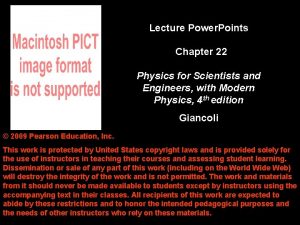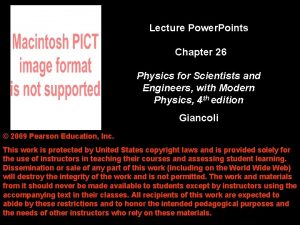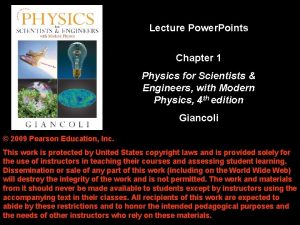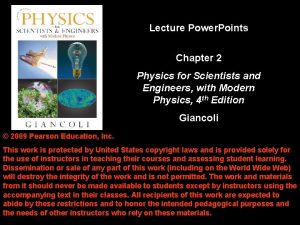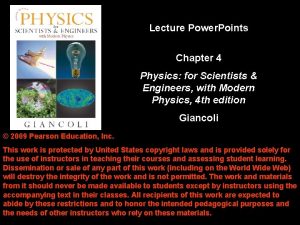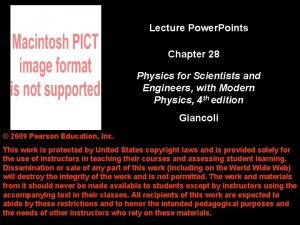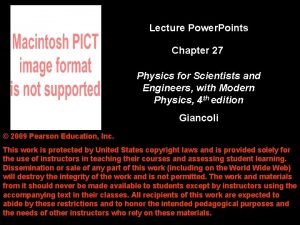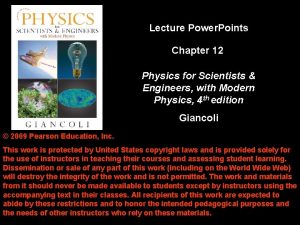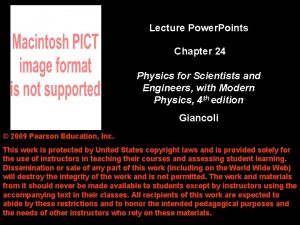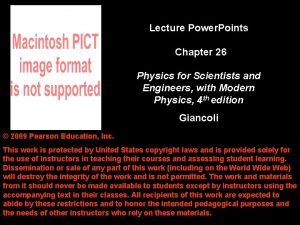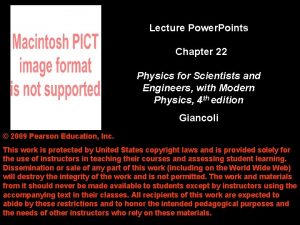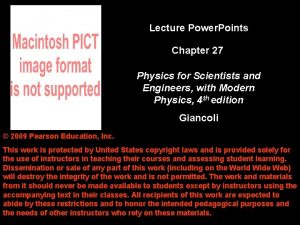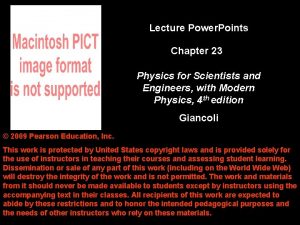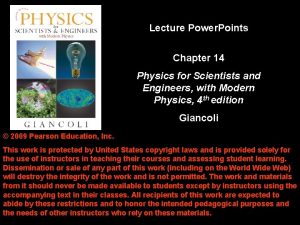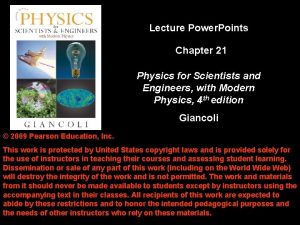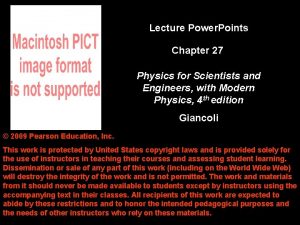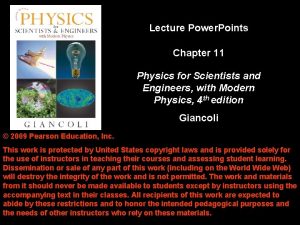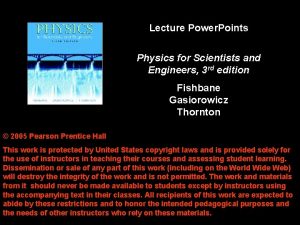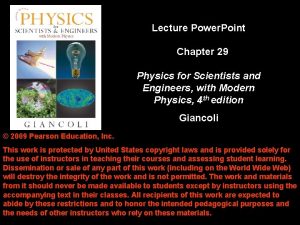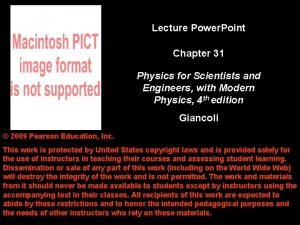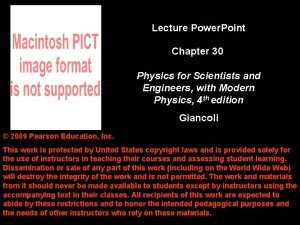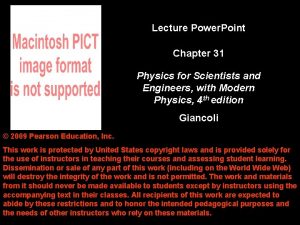Lecture Power Points Chapter 25 Physics for Scientists




























































- Slides: 60

Lecture Power. Points Chapter 25 Physics for Scientists and Engineers, with Modern Physics, 4 th edition Giancoli © 2009 Pearson Education, Inc. This work is protected by United States copyright laws and is provided solely for the use of instructors in teaching their courses and assessing student learning. Dissemination or sale of any part of this work (including on the World Wide Web) will destroy the integrity of the work and is not permitted. The work and materials from it should never be made available to students except by instructors using the accompanying text in their classes. All recipients of this work are expected to abide by these restrictions and to honor the intended pedagogical purposes and the needs of other instructors who rely on these materials. Copyright © 2009 Pearson Education, Inc.

Chapter 25 Electric Currents and Resistance Copyright © 2009 Pearson Education, Inc.

Units of Chapter 25 • The Electric Battery • Electric Current • Ohm’s Law: Resistance and Resistors • Resistivity • Electric Power Copyright © 2009 Pearson Education, Inc.

Units of Chapter 25 • Power in Household Circuits • Alternating Current • Microscopic View of Electric Current: Current Density and Drift Velocity • Superconductivity • Electrical Conduction in the Nervous System Copyright © 2009 Pearson Education, Inc.

25 -1 The Electric Battery Volta discovered that electricity could be created if dissimilar metals were connected by a conductive solution called an electrolyte. This is a simple electric cell. Copyright © 2009 Pearson Education, Inc.

25 -1 The Electric Battery A battery transforms chemical energy into electrical energy. Chemical reactions within the cell create a potential difference between the terminals by slowly dissolving them. This potential difference can be maintained even if a current is kept flowing, until one or the other terminal is completely dissolved. Copyright © 2009 Pearson Education, Inc.

25 -1 The Electric Battery Several cells connected together make a battery, although now we refer to a single cell as a battery as well. Copyright © 2009 Pearson Education, Inc.

25 -2 Electric Current Electric current is the rate of flow of charge through a conductor: The instantaneous current is given by: Unit of electric current: the ampere, A: 1 A = 1 C/s. Copyright © 2009 Pearson Education, Inc.

25 -2 Electric Current A complete circuit is one where current can flow all the way around. Note that the schematic drawing doesn’t look much like the physical circuit! Copyright © 2009 Pearson Education, Inc.

25 -2 Electric Current Example 25 -1: Current is flow of charge. A steady current of 2. 5 A exists in a wire for 4. 0 min. (a) How much total charge passed by a given point in the circuit during those 4. 0 min? (b) How many electrons would this be? Copyright © 2009 Pearson Education, Inc.

25 -2 Electric Current Conceptual Example 25 -2: How to connect a battery. What is wrong with each of the schemes shown for lighting a flashlight bulb with a flashlight battery and a single wire? Copyright © 2009 Pearson Education, Inc.

25 -2 Electric Current By convention, current is defined as flowing from + to -. Electrons actually flow in the opposite direction, but not all currents consist of electrons. Copyright © 2009 Pearson Education, Inc.

25 -3 Ohm’s Law: Resistance and Resistors Experimentally, it is found that the current in a wire is proportional to the potential difference between its ends: Copyright © 2009 Pearson Education, Inc.

25 -3 Ohm’s Law: Resistance and Resistors The ratio of voltage to current is called the resistance: Copyright © 2009 Pearson Education, Inc.

25 -3 Ohm’s Law: Resistance and Resistors In many conductors, the resistance is independent of the voltage; this relationship is called Ohm’s law. Materials that do not follow Ohm’s law are called nonohmic. Unit of resistance: the ohm, Ω: 1 Ω = 1 V/A. Copyright © 2009 Pearson Education, Inc.

25 -3 Ohm’s Law: Resistance and Resistors Conceptual Example 25 -3: Current and potential. Current I enters a resistor R as shown. (a) Is the potential higher at point A or at point B? (b) Is the current greater at point A or at point B? Copyright © 2009 Pearson Education, Inc.

25 -3 Ohm’s Law: Resistance and Resistors Example 25 -4: Flashlight bulb resistance. A small flashlight bulb draws 300 m. A from its 1. 5 -V battery. (a) What is the resistance of the bulb? (b) If the battery becomes weak and the voltage drops to 1. 2 V, how would the current change? Copyright © 2009 Pearson Education, Inc.

25 -3 Ohm’s Law: Resistance and Resistors Standard resistors are manufactured for use in electric circuits; they are color-coded to indicate their value and precision. Copyright © 2009 Pearson Education, Inc.

25 -3 Ohm’s Law: Resistance and Resistors This is the standard resistor color code. Note that the colors from red to violet are in the order they appear in a rainbow. Copyright © 2009 Pearson Education, Inc.

25 -3 Ohm’s Law: Resistance and Resistors Some clarifications: • Batteries maintain a (nearly) constant potential difference; the current varies. • Resistance is a property of a material or device. • Current is not a vector but it does have a direction. • Current and charge do not get used up. Whatever charge goes in one end of a circuit comes out the other end. Copyright © 2009 Pearson Education, Inc.

25 -4 Resistivity The resistance of a wire is directly proportional to its length and inversely proportional to its cross-sectional area: The constant ρ, the resistivity, is characteristic of the material. Copyright © 2009 Pearson Education, Inc.

25 -4 Resistivity This table gives the resistivity and temperature coefficients of typical conductors, semiconductors, and insulators. Copyright © 2009 Pearson Education, Inc.

25 -4 Resistivity Example 25 -5: Speaker wires. Suppose you want to connect your stereo to remote speakers. (a) If each wire must be 20 m long, what diameter copper wire should you use to keep the resistance less than 0. 10 Ω per wire? (b) If the current to each speaker is 4. 0 A, what is the potential difference, or voltage drop, across each wire? Copyright © 2009 Pearson Education, Inc.

25 -4 Resistivity Conceptual Example 25 -6: Stretching changes resistance. Suppose a wire of resistance R could be stretched uniformly until it was twice its original length. What would happen to its resistance? Copyright © 2009 Pearson Education, Inc.

25 -4 Resistivity For any given material, the resistivity increases with temperature: Semiconductors are complex materials, and may have resistivities that decrease with temperature. Copyright © 2009 Pearson Education, Inc.

25 -4 Resistivity Example 25 -7: Resistance thermometer. The variation in electrical resistance with temperature can be used to make precise temperature measurements. Platinum is commonly used since it is relatively free from corrosive effects and has a high melting point. Suppose at 20. 0°C the resistance of a platinum resistance thermometer is 164. 2 Ω. When placed in a particular solution, the resistance is 187. 4 Ω. What is the temperature of this solution? Copyright © 2009 Pearson Education, Inc.

25 -5 Electric Power, as in kinematics, is the energy transformed by a device per unit time: or Copyright © 2009 Pearson Education, Inc.

25 -5 Electric Power The unit of power is the watt, W. For ohmic devices, we can make the substitutions: Copyright © 2009 Pearson Education, Inc.

25 -5 Electric Power Example 25 -8: Headlights. Calculate the resistance of a 40 -W automobile headlight designed for 12 V. Copyright © 2009 Pearson Education, Inc.

25 -5 Electric Power What you pay for on your electric bill is not power, but energy – the power consumption multiplied by the time. We have been measuring energy in joules, but the electric company measures it in kilowatt-hours, k. Wh: 1 k. Wh = (1000 W)(3600 s) = 3. 60 x 106 J. Copyright © 2009 Pearson Education, Inc.

25 -5 Electric Power Example 25 -9: Electric heater. An electric heater draws a steady 15. 0 A on a 120 -V line. How much power does it require and how much does it cost per month (30 days) if it operates 3. 0 h per day and the electric company charges 9. 2 cents per k. Wh? Copyright © 2009 Pearson Education, Inc.

25 -5 Electric Power Example 25 -10: Lightning bolt. Lightning is a spectacular example of electric current in a natural phenomenon. There is much variability to lightning bolts, but a typical event can transfer 109 J of energy across a potential difference of perhaps 5 x 107 V during a time interval of about 0. 2 s. Use this information to estimate (a) the total amount of charge transferred between cloud and ground, (b) the current in the lightning bolt, and (c) the average power delivered over the 0. 2 s. Copyright © 2009 Pearson Education, Inc.

25 -6 Power in Household Circuits The wires used in homes to carry electricity have very low resistance. However, if the current is high enough, the power will increase and the wires can become hot enough to start a fire. To avoid this, we use fuses or circuit breakers, which disconnect when the current goes above a predetermined value. Copyright © 2009 Pearson Education, Inc.

25 -6 Power in Household Circuits Fuses are one-use items – if they blow, the fuse is destroyed and must be replaced. Copyright © 2009 Pearson Education, Inc.

25 -6 Power in Household Circuits Circuit breakers, which are now much more common in homes than they once were, are switches that will open if the current is too high; they can then be reset. Copyright © 2009 Pearson Education, Inc.

25 -6 Power in Household Circuits Example 25 -11: Will a fuse blow? Determine the total current drawn by all the devices in the circuit shown. Copyright © 2009 Pearson Education, Inc.

25 -6 Power in Household Circuits Conceptual Example 25 -12: A dangerous extension cord. Your 1800 -W portable electric heater is too far from your desk to warm your feet. Its cord is too short, so you plug it into an extension cord rated at 11 A. Why is this dangerous? Copyright © 2009 Pearson Education, Inc.

25 -7 Alternating Current from a battery flows steadily in one direction (direct current, DC). Current from a power plant varies sinusoidally (alternating current, AC). Copyright © 2009 Pearson Education, Inc.

25 -7 Alternating Current The voltage varies sinusoidally with time: , , as does the current: Copyright © 2009 Pearson Education, Inc.

25 -7 Alternating Current Multiplying the current and the voltage gives the power: Copyright © 2009 Pearson Education, Inc.

25 -7 Alternating Current Usually we are interested in the average power: . Copyright © 2009 Pearson Education, Inc.

25 -7 Alternating Current The current and voltage both have average values of zero, so we square them, take the average, then take the square root, yielding the root-mean-square (rms) value: Copyright © 2009 Pearson Education, Inc.

25 -7 Alternating Current Example 25 -13: Hair dryer. (a) Calculate the resistance and the peak current in a 1000 -W hair dryer connected to a 120 -V line. (b) What happens if it is connected to a 240 -V line in Britain? Copyright © 2009 Pearson Education, Inc.

25 -8 Microscopic View of Electric Current: Current Density and Drift Velocity Electrons in a conductor have large, random speeds just due to their temperature. When a potential difference is applied, the electrons also acquire an average drift velocity, which is generally considerably smaller than thermal velocity. Copyright © 2009 Pearson Education, Inc.

25 -8 Microscopic View of Electric Current: Current Density and Drift Velocity We define the current density (current per unit area) – this is a convenient concept for relating the microscopic motions of electrons to the macroscopic current: If the current is not uniform: . Copyright © 2009 Pearson Education, Inc.

25 -8 Microscopic View of Electric Current: Current Density and Drift Velocity This drift speed is related to the current in the wire, and also to the number of electrons per unit volume: and Copyright © 2009 Pearson Education, Inc.

25 -8 Microscopic View of Electric Current: Current Density and Drift Velocity Example 25 -14: Electron speeds in a wire. A copper wire 3. 2 mm in diameter carries a 5. 0 A current. Determine (a) the current density in the wire, and (b) the drift velocity of the free electrons. (c) Estimate the rms speed of electrons assuming they behave like an ideal gas at 20°C. Assume that one electron per Cu atom is free to move (the others remain bound to the atom). Copyright © 2009 Pearson Education, Inc.

25 -8 Microscopic View of Electric Current: Current Density and Drift Velocity The electric field inside a current-carrying wire can be found from the relationship between the current, voltage, and resistance. Writing R = ρ l/A, I = j. A, and V = El , and substituting in Ohm’s law gives: Copyright © 2009 Pearson Education, Inc.

25 -8 Microscopic View of Electric Current: Current Density and Drift Velocity Example 25 -15: Electric field inside a wire. What is the electric field inside the wire of Example 25– 14? (The current density was found to be 6. 2 x 105 A/m 2. ) Copyright © 2009 Pearson Education, Inc.

25 -9 Superconductivity In general, resistivity decreases as temperature decreases. Some materials, however, have resistivity that falls abruptly to zero at a very low temperature, called the critical temperature, TC. Copyright © 2009 Pearson Education, Inc.

25 -9 Superconductivity Experiments have shown that currents, once started, can flow through these materials for years without decreasing even without a potential difference. Critical temperatures are low; for many years no material was found to be superconducting above 23 K. Since 1987, new materials have been found that are superconducting below 90 K, and work on higher temperature superconductors is continuing. Copyright © 2009 Pearson Education, Inc.

25 -10 Electrical Conduction in the Nervous System The human nervous system depends on the flow of electric charge. The basic elements of the nervous system are cells called neurons. Neurons have a main cell body, small attachments called dendrites, and a long tail called the axon. Copyright © 2009 Pearson Education, Inc.

25 -10 Electrical Conduction in the Nervous System Signals are received by the dendrites, propagated along the axon, and transmitted through a connection called a synapse. Copyright © 2009 Pearson Education, Inc.

25 -10 Electrical Conduction in the Nervous System This process depends on there being a dipole layer of charge on the cell membrane, and different concentrations of ions inside and outside the cell. Copyright © 2009 Pearson Education, Inc.

25 -10 Electrical Conduction in the Nervous System This applies to most cells in the body. Neurons can respond to a stimulus and conduct an electrical signal. This signal is in the form of an action potential. Copyright © 2009 Pearson Education, Inc.

25 -10 Electrical Conduction in the Nervous System The action potential propagates along the axon membrane. Copyright © 2009 Pearson Education, Inc.

Summary of Chapter 25 • A battery is a source of constant potential difference. • Electric current is the rate of flow of electric charge. • Conventional current is in the direction that positive charge would flow. • Resistance is the ratio of voltage to current: Copyright © 2009 Pearson Education, Inc.

Summary of Chapter 25 • Ohmic materials have constant resistance, independent of voltage. • Resistance is determined by shape and material: • ρ is the resistivity. Copyright © 2009 Pearson Education, Inc.

Summary of Chapter 25 • Power in an electric circuit: • Direct current is constant. • Alternating current varies sinusoidally: Copyright © 2009 Pearson Education, Inc.

Summary of Chapter 25 • The average (rms) current and voltage: • Relation between drift speed and current: Copyright © 2009 Pearson Education, Inc.
 01:640:244 lecture notes - lecture 15: plat, idah, farad
01:640:244 lecture notes - lecture 15: plat, idah, farad Active power reactive power apparent power
Active power reactive power apparent power Brand positioning bull's eye
Brand positioning bull's eye Point of difference and point of parity
Point of difference and point of parity Physics 111 lecture notes
Physics 111 lecture notes What is a harmonic wave in physics
What is a harmonic wave in physics Phy101 lecture 1
Phy101 lecture 1 Physics 101 lecture notes pdf
Physics 101 lecture notes pdf Waves physics notes pdf download
Waves physics notes pdf download Atmospheric physics lecture notes
Atmospheric physics lecture notes Power system dynamics and stability lecture notes
Power system dynamics and stability lecture notes Power system analysis lecture notes
Power system analysis lecture notes Power semiconductor devices lecture notes
Power semiconductor devices lecture notes Switch mode power supply lecture notes
Switch mode power supply lecture notes Power system dynamics and stability lecture notes
Power system dynamics and stability lecture notes Prayer point for power and authority
Prayer point for power and authority Why does it happen
Why does it happen University physics with modern physics fifteenth edition
University physics with modern physics fifteenth edition Easy physics ia ideas
Easy physics ia ideas Kontinuitetshantering i praktiken
Kontinuitetshantering i praktiken Novell typiska drag
Novell typiska drag Tack för att ni lyssnade bild
Tack för att ni lyssnade bild Returpilarna
Returpilarna Shingelfrisyren
Shingelfrisyren En lathund för arbete med kontinuitetshantering
En lathund för arbete med kontinuitetshantering Underlag för särskild löneskatt på pensionskostnader
Underlag för särskild löneskatt på pensionskostnader Personlig tidbok
Personlig tidbok Anatomi organ reproduksi
Anatomi organ reproduksi Densitet vatten
Densitet vatten Datorkunskap för nybörjare
Datorkunskap för nybörjare Boverket ka
Boverket ka Tes debattartikel
Tes debattartikel Magnetsjukhus
Magnetsjukhus Nyckelkompetenser för livslångt lärande
Nyckelkompetenser för livslångt lärande Påbyggnader för flakfordon
Påbyggnader för flakfordon Vätsketryck formel
Vätsketryck formel Publik sektor
Publik sektor Lyckans minut erik lindorm analys
Lyckans minut erik lindorm analys Presentera för publik crossboss
Presentera för publik crossboss Teckenspråk minoritetsspråk argument
Teckenspråk minoritetsspråk argument Vem räknas som jude
Vem räknas som jude Treserva lathund
Treserva lathund Luftstrupen för medicinare
Luftstrupen för medicinare Bästa kameran för astrofoto
Bästa kameran för astrofoto Cks
Cks Programskede byggprocessen
Programskede byggprocessen Mat för idrottare
Mat för idrottare Verktyg för automatisering av utbetalningar
Verktyg för automatisering av utbetalningar Rutin för avvikelsehantering
Rutin för avvikelsehantering Smärtskolan kunskap för livet
Smärtskolan kunskap för livet Ministerstyre för och nackdelar
Ministerstyre för och nackdelar Tack för att ni har lyssnat
Tack för att ni har lyssnat Referatmarkering
Referatmarkering Redogör för vad psykologi är
Redogör för vad psykologi är Stål för stötfångarsystem
Stål för stötfångarsystem Tack för att ni har lyssnat
Tack för att ni har lyssnat Borra hål för knoppar
Borra hål för knoppar Vilken grundregel finns det för tronföljden i sverige?
Vilken grundregel finns det för tronföljden i sverige? Standardavvikelse formel
Standardavvikelse formel Tack för att ni har lyssnat
Tack för att ni har lyssnat Rita perspektiv
Rita perspektiv





























































